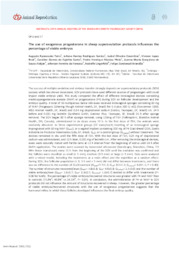The use of exogenous progesterone in sheep superovulation protocols influences the percentage of viable embryos.
The use of exogenous progesterone in sheep superovulation protocols influences the percentage of viable embryos.
Author(s): TAIRA, A. R.; SANTOS, J. D. R.; COSENTINO, I. O.; BRAIR, V. L.; ESPÍRITO SANTO, C. G. do; PINTO, P. H. N.; SOUZA-FABJAN, J. M. G. de; FONSECA, J. F. da; UNGERFELD, R.; BRANDÃO, J. Z.
Summary: The success of multiple ovulation and embryo transfer strongly depends on superovulatory protocols (SOV) success which has shown inconstant. SOV protocols have used different sources of progestogen with could impact viable embryo yield. This study compared the effect of different intravaginal devices containing medroxyprogesterone acetate (MAP) or progesterone (P4) during SOV on follicular development and the embryo quality. In conclusion, the administration of P4 or MAP in SOV protocols did not influence the amount of structures recovered in sheep. However, the greater percentage of viable embryos/recovered structures with the use of exogenous progesterone suggests that the hormonal milieu in which these follicles developed influences the final embryo quality.
Publication year: 2020
Types of publication: Abstract in annals or event proceedings
Unit: Embrapa Goats & Sheep
Keywords: Animal reproduction, Embryo transfer, Progesterone, Sheep, Superovulation
Observation
Some of Embrapa's publications are published as ePub files. To read them, use or download one of the following free software options to your computer or mobile device. Android: Google Play Books; IOS: iBooks; Windows and Linux: Calibre.
Access other publications
Access the Agricultural Research Database (BDPA) to consult Embrapa's full library collection and records.
Visit Embrapa Bookstore to purchase books and other publications sold by Embrapa.

